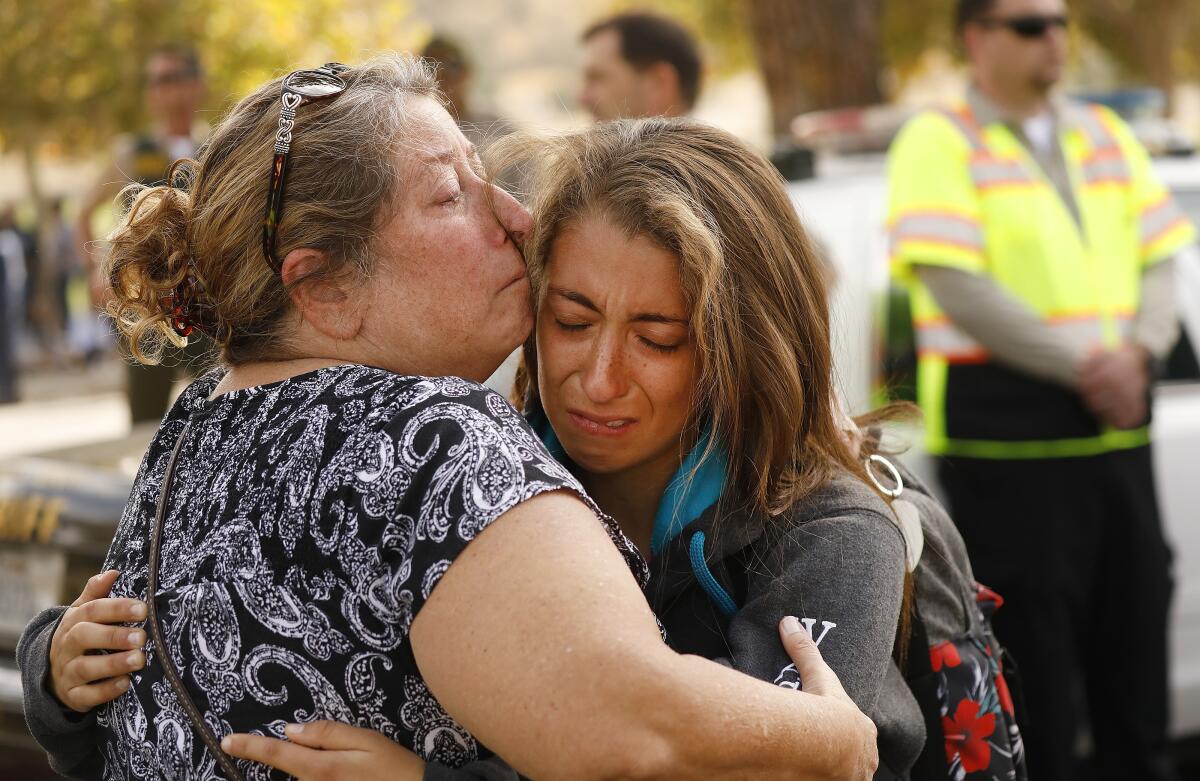Santa Clarita shooting: Some fear active shooter training at schools can bring its own form of trauma

- Share via
When gunfire erupted in the Saugus High School quad Thursday morning, students had mere seconds to react. They sprinted and threw themselves in a ditch for cover. They hid in closets, locked and barricaded doors with desks. And some readied for a possible fight, arming themselves with scissors or a fire extinguisher.
The range of quick actions by some 2,000 students and staff reveals not only how detailed active shooter training has become at schools across the country, but highlights a growing debate among school safety experts, some who are alarmed that increasingly aggressive drills have gone too far and risk becoming trauma-inducing events of their own.
The trainings sometimes contain graphic and realistic enactments — one in Indiana recently involved shooting teachers “execution-style” with a pellet gun — and may cause distress or even injuries for those involved, critics said.
“Going through these drills can be itself a traumatic event,” said Deborah Temkin, senior director of education research at Child Trends, a nonprofit research organization. “We really have to weigh that potential trauma with the benefit that could be gained.”
But lockdowns and sheltering in place are no longer enough, some school safety experts said.
Students are increasingly being taught a “run, hide, fight” strategy that focuses on how to decide whether to flee, hole up or go on the attack themselves — and how to make split-second decisions on what option could offer the best chance of survival.
The Saugus High shooting lasted only 16 seconds, killing two students and wounding three others. The 16-year-old student shooter died Friday of a self-inflicted gunshot.
The swift outburst of violence at Saugus reflected the time duration of school shootings nationwide. An analysis of 41 school shootings between 2008 and 2017 by the Secret Service’s National Threat Assessment Center found two-thirds of attacks lasted less than two minutes and nearly half were over in under 60 seconds.
“What is so important is to really empower every individual to make a quick 15-second or shorter decision, ‘What am I going to do now?’,” said Joe Deedon, a former SWAT officer who runs an active shooter training company in Denver that teaches kids as young as sixth grade how to go on the offensive.
“We don’t want you to be a hero ... and die,” Deedon said, “but yet, here are the options you have.”
But it’s this choice-based approach that deeply concerns some safety consultants and educators who say it creates physical and psychological dangers with no evidence that it saves lives.
Sixteen states, including California, now require or encourage schools to carry out active shooter drills, according to one analysis, and 95% of schools nationwide conducted a drill in the 2014-2015 school year, according to the National Center for Education Statistics.
At many Santa Clarita Valley schools, including Saugus High, law enforcement coordinates training, said Los Angeles County Sheriff’s Capt. Robert Lewis. The local sheriff’s station runs two impromptu drills at elementary schools every year. High school and middle school administrators practice at least once a month — Saugus drilled just three weeks ago.
As school districts seek new ways to protect their charges, an industry of crisis experts has sprung up with courses largely based on law enforcement and security protocols — many with methods that have not been rigorously evaluated for a school environment.
“There is not a lot of consistency,” said Ken Trump, an Ohio-based school safety consultant who opposes choice-based training in schools. “The devil is in the details of implementation.”
After the Columbine shooting in 1999, in which 13 people were killed and more than 20 wounded by two shooters, schools began practicing lockdowns to handle a crisis on campus. Yet recent attacks suggest shooters may have learned to circumvent them, safety experts said.
Last year, when a former student opened fire with a semiautomatic rifle at Marjory Stoneman Douglas High School in Parkland, Fla., killing 17, he first set off the fire alarms to draw people out of classrooms. Thursday, at Saugus, the shooter opened fire in an outdoor quad early in the morning, before many classes had started. Friday night, a gunman attacked during a high school football game in New Jersey.
Deedon said more aggressive training is needed because students, faced with situations where lockdowns don’t work, are already taking matters into their own hands regardless of what is being taught.
In October, a 14-year-old freshman at La Habra High School in Orange County was wrestled to the ground and disarmed by classmates after brandishing an unloaded gun in a shop class. In May, four Colorado teens charged a classmate after he pulled a gun in a British literature class. The first student to reach him, Kendrick Castillo, was killed, but the gunman was disarmed before there were more fatalities.
Deedon said Castillo’s death represented a “huge turning point” for how some safety experts view what kids and educators should be taught about active shooters.
“You are starting to see young people, young adults, start to jump into action at their own doing, without any coaching and without any training,” Deedon said. “The last six months to a year has really shown us that really the whole shelter-in-place, lockdown mentality is way behind the curve.”
Teaching kids to fight or self-evacuate in a shooting is a fear-based response to a rare danger, said those who favor a more cautious approach.
“We have to make sure we are not doing more harm than good,” said Trump, the school safety consultant. He believes lockdowns are the “gold standard” for a reason.
“We know that lockdowns work,” he said.
The tactic provides the most benefit with the least risk, Trump said. He added there is little empirical evidence that fighting or running saves more lives — and few kids have the mental maturity to make accurate assessments of their best options.
Trump pointed to instances in which one Alabama school considered having students keep canned goods nearby to throw at assailants if needed, and a Pennsylvania school that put buckets of rocks in each classroom last year as examples of how the trend toward fighting back might scare kids without providing a documented benefit.
With choice-based models, Trump said, “We are asking kids in these programs to make adult decisions when their brains have not reached that capacity.”
School safety consultant Chris Dorn said that many of the current run, hide, fight models used in schools aren’t appropriate because they were never intended for educational settings. The model was developed by the city of Houston for settings such as airports and malls, he said.
Trump also pointed out that moving away from lockdowns may leave students with disabilities or special needs behind.
The issue of disabled kids is bubbling up in crisis planning in many schools, including those in Southern California. Los Angeles Unified school board members voted in September to require schools to conduct a lockdown drill within the first month of each semester, and that each school’s safety plan should include provisions for students with disabilities.
The new policy will take effect next school year; currently schools are supposed to conduct two lockdown drills a year.
“LAUSD is currently reviewing several age-appropriate and trauma-informed active shooter drills and training programs,” Los Angeles School Police Department Lt. Aaron Pisarzewicz.
Melissa Brymer, director of terrorism and disaster programs at the UCLA-Duke National Center for Child Traumatic Stress, says active shooter drills are necessary and whether they are traumatic depends on how they are implemented.
Like Trump, she thinks surprise drills or simulations that include shooting blanks or using fake blood, can be unnecessarily anxiety provoking for students and staff.
“We need to make sure we’re doing it in an environment that is conducive to learning,” Brymer said. “In fire drills, we don’t actually cause a fire in the building for kids and staff to take that drill seriously.”
But Pete Blair, a criminal justice professor at Texas State University who helped develop the choice-based strategy, said that additional tactics and training could also have the opposite effect and make students feel more secure.
“Kids are aware these things are happening and the fact that you address it and give them a set of strategies to deal with these situations, they actually like that because it allows them to feel empowered,” he said.
Ideally, Blair and others said, instinct and training blend in a moment of crisis and students and teachers simply implement what they have learned.
Blair called out the actions of Saugus High’s 26-year-old choir teacher Kaitlin Holt as an example of exemplary preparation.
Thursday morning, Holt’s pupils were listening to a recording of themselves singing at a jazz festival when some students fled into her room. She locked and barricaded the door, moving students into an office within the classroom.
There, a female freshman realized she had been struck by gunfire.
“Her adrenaline was so high she didn’t know she had been shot,” Holt said.
Holt recalled a training video on gunshot wounds she had watched at a staff meeting, and reached for the “gunshot wound kit” kept in each classroom to stanch the bleeding while a senior guarded the office door with a fire extinguisher, ready to attack. The were eventually escorted to safety by police, and the girl is expected to fully recover.
Blair said Holt’s fast and effective response was “a fantastic thing that absolutely should be recognized.”
But the young teacher doesn’t see it that way.
“It was just fight or flight,” Holt said. “I didn’t have time to think of anything except survival for my students.”
Times staff writers Sonali Kohli and Brittny Mejia contributed to this report.
More to Read
Sign up for Essential California
The most important California stories and recommendations in your inbox every morning.
You may occasionally receive promotional content from the Los Angeles Times.
















